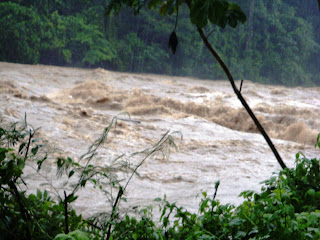While we haven't had any named tropical storms come near Honduras yet this hurricane season, the country is suffering from terrible flooding from the rains. So far, 33 people have died, 16 are missing, 58,000 people are homeless, and hundreds of thousands of homes have been damaged.
 Families are living in shelters or with relatives − if they are lucky − or in tarp covered stick shelters along the river banks and even in the median strips of the highways with no food, clothes, or sanitary facilities. More than 100,000 manzanas (168,000 acres) of crops have been lost. (Photo, El Progreso: La Prensa, Honduras)
Families are living in shelters or with relatives − if they are lucky − or in tarp covered stick shelters along the river banks and even in the median strips of the highways with no food, clothes, or sanitary facilities. More than 100,000 manzanas (168,000 acres) of crops have been lost. (Photo, El Progreso: La Prensa, Honduras)During the last 24 hours, we've had almost constant rain in La Ceiba. Some of it has been very heavy. I would estimate that we've had at least 4-5 inches (10-13 cm.).
Some information that I received from Dave Ashby of Helping Honduras Kids is this:
A cold front just went by and another is on the way in a few hours. It rained much harder in the mountains than it did in Ceiba and the Cangrejal river came up high, fast and furious. I went to the Jungle School, where there were no students, volunteers or teachers, but the school is ok. Scott, the missionary from Porvenir went by and said the road is washed out farther up, where this happened in December 2 years ago.
There is apparently no passage between Tela and Ceiba, between San Pedro Sula and Tela and between Tegucigalpa and SPS.
I have attached 2 photos of the Cangrejal river, taken near our Jungle School. Pretty wild. It could get worse if the next cold front is very strong. Anyone for Class 8 rafting? Hope the bridges hold. Families along the river edge are having to move to higher ground, just like in La Lima.
More later,
Dave
A little later, Dave sent this:
They just closed the Saopin bridge across the Cangrejal. The other bridge is still open.
Our children are all well so far, just some hungry ones that we are dealing with. Pepe Herrero (USAID) is helping us.
El Jefe was in town and I called him to say "COME HOME NOW!" before they close the only other bridge between here and town. He made it. He said the river was scary and he didn't want to stop the car to take a photo.
 For comparison purposes, this is what the rivers in La Ceiba usually look like. This photo is not the same part of the river as Dave's photos. In fact, this photo may be of Rio Danto, a few miles away, but Rio Cangrejal in town normally looks very similar to this.
For comparison purposes, this is what the rivers in La Ceiba usually look like. This photo is not the same part of the river as Dave's photos. In fact, this photo may be of Rio Danto, a few miles away, but Rio Cangrejal in town normally looks very similar to this.For a view of what is happening in other areas of Honduras, check out the videos on the Project Honduras site. I haven't had a chance to check YouTube, but I imagine that there are many more videos.
 I'm going to guess that once upon a time, the country could have handled 5 or 10 inches of rain. No more. With forests clear cut and mountains striped of all trees, river basins dug out for sand and gravel for construction purposes, and rivers and sewage systems stuffed to the gills with garbage and trash, the country has been raped of all it's natural protections. (Photo, Trujillo, Colon: La Prensa, Honduras)
I'm going to guess that once upon a time, the country could have handled 5 or 10 inches of rain. No more. With forests clear cut and mountains striped of all trees, river basins dug out for sand and gravel for construction purposes, and rivers and sewage systems stuffed to the gills with garbage and trash, the country has been raped of all it's natural protections. (Photo, Trujillo, Colon: La Prensa, Honduras)It makes me very angry that people are suffering so. This isn't a natural disaster. It is an unnatural disaster caused primarily by greed, corruption, and ignorance. I'd love to know how many millions of dollars of aid have been sent to Honduras to combat these issues and I'd like to know where it went.
I've been happy to see so many reports of Hondurans helping other Hondurans with donated food, clothing, and shelter. El Jefe tells me that Hondurans don't like to give cash, because there is always that worry of corruption.
If you are interested in helping in some way, check out Dave's HHK organization in La Ceiba or Project Honduras. Project Honduras is a sort of NGO networking community for Honduras and they can probably point you in the right direction.
Related article: Floods in Honduras, Todd Rules



 Welcome to my Blogicito —
Welcome to my Blogicito — 







